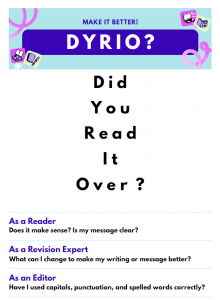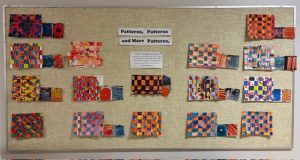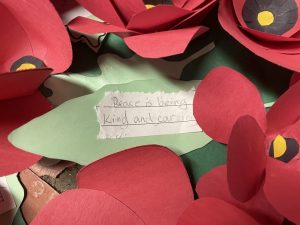Dear families,
We hope you enjoyed your extra hour today!
We are writers.
 On Monday, Ms. Kim and I had our second opportunity to team teach. We carried on with our lesson about paragraph writing (about gratitude) to learn about how to reflect on our writing to make it better. We introduced DYRIO? This stands for “Did you read it over?”
On Monday, Ms. Kim and I had our second opportunity to team teach. We carried on with our lesson about paragraph writing (about gratitude) to learn about how to reflect on our writing to make it better. We introduced DYRIO? This stands for “Did you read it over?”
This is something I created many years ago when I was on Staff Development teaching writing strategies. I noticed that when I taught it to other teachers, many would message me the next day telling me they tried this and loved it because it worked immediately! In my own practice teaching grades 1-5, I noticed that student writing greatly improved with this one small change: Ask students to re-read their writing at least three times before handing it in.
Click on the DYRIO image to view the full PDF.
On most days after Heart Time (soft start), we review a morning message where we fix Ms. Kim’s or Ms. Chan’s mistakes. We practice editing so they are developing editing skills when they look at their own writing.
When students hand in work, they are asked, “DYRIO?” This is what it means:
- Read – 1st time: Read it like a reader as if you are reading someone else’s writing. The key to any writing is clarity. You can have the right spelling or use proper punctuation but if the message isn’t clear, it is difficult for your audience to understand.
- Read – 2nd time: Read it like a revision expert. Your job is to look for ways to improve your writing. We have many mini-lessons planned to help with this like learning about adjectives, adverbs, synonyms, word choice, etc. Often, I will ask them to show me what they made better. Last week, Ms. Kim taught them how to write “super sentences” to learn how to add more details and “triple scoop words”. “Triple scoop words” is a term used to encourage students to choose rich, descriptive vocabulary, similar to getting a “triple scoop” of ice cream instead of a single. These words go beyond basic language (like “good” or “nice”) to provide a fuller, more vivid picture, adding “extra flavor” to writing.For example:
- Instead of saying “happy,” students might choose “ecstatic” or “overjoyed.”
- Rather than “big,” they could use “enormous” or “gigantic.”
- Read – 3rd time: Read it like an editor looking for capitals to start sentences and for names, proper punctuation, spelling and grammar.
This process is actually what publishing companies do when they edit books to be published. Check clarity, make it better, and lastly, editing.
Ways to support at home: For all students, we have a goal to improve written communication skills so writing at home is a great way to improve. Students can keep a journal or write a letter to someone (This is so novel now!). You can have fun co-writing a story together! Bookmaking is one of our student’s favourite activities in school so try it at home with them! Then after they write, ask them to DYRIO to reinforce reflecting on their message clarity, working on improving it, and then editing. Read it with them and talk through your thought processes. You are modelling what a writer thinks during revision and editing stages.
Comfort zone circles
 I have been wanting to teach this lesson since September. This is one of my signature lessons on growth mindset! Teacher2Teacher loved my story that they interviewed me and published a blog post about my Comfort zone circles lesson. Feel free to read the blog post. It is titled “A Simple Way I Show Students They’re Growing Every Day.”
I have been wanting to teach this lesson since September. This is one of my signature lessons on growth mindset! Teacher2Teacher loved my story that they interviewed me and published a blog post about my Comfort zone circles lesson. Feel free to read the blog post. It is titled “A Simple Way I Show Students They’re Growing Every Day.”
I don’t call the red zone the panic zone anymore. It’s now called “Not Yet Zone” which is more appropriate for a growth mindset approach.
We played a game where I moved the carpet to the middle of the room to represent our comfort zone. Then I called out different scenarios for  them to decide how comfortable they were doing it. Then they had fun taking turns to come up with scenarios for their classmates. For example:
them to decide how comfortable they were doing it. Then they had fun taking turns to come up with scenarios for their classmates. For example:
- riding a bike
- going swimming in a pool, lake, or ocean
- speaking in front of the whole school
Afterwards, students created their own comfort zone circles listing things that were in their comfort zone, stretch zone, and not yet zone.
The key to this lesson is learning that we want to be in our stretch zone. This is optimal and where most learning happens. When things are too easy, we don’t feel challenge and we don’t grow much. But in our stretch zone, we experience productive struggle, take risks, and overcome the hurdles and learn that we can do hard things. We talked about affirmations and shared ideas about what affirmations we can say to ourselves:
- You can do this!
- I am doing my best.
- You can do hard things!
 Follow up story: We read a story that one of my friend’s wrote: Cannonball In by Tara Martin. From Amazon:
Follow up story: We read a story that one of my friend’s wrote: Cannonball In by Tara Martin. From Amazon:
From the shallow end of the pool, Olivia watches the flippers, the graceful divers, and her favorite—the cannonballers! Wave after wave, she wishes she could make a splash.
But she’s afraid! In the deep end of the pool, she can’t reach the bottom. Plus the dabblers are there, sitting on the side of the pool and laughing at her!
With a little encouragement from her dad and a whole lot of gumption, Olivia heads to the diving board. But will she be brave enough to take the leap?
In this beautifully illustrated picture book, Tara Martin inspires young readers to find their courage and cannonball in—no matter what the naysayers (and the voice of fear) are chanting.
Ways to support: Have a conversation about being brave to take risks.
Diwali
We greatly appreciate Ziya who shared how she celebrates Diwali with her family. We learned about who celebrates around the world, when, why it is celebrated, what it means, and how they celebrate while also learning some variations depending on where they are in the world.
Diwali, the “Festival of Lights,” celebrates the triumph of light over darkness and good over evil. Families decorate with oil lamps and colorful rangoli, light fireworks, share sweets, and exchange gifts. It’s a joyful time of gratitude, reflection, and togetherness.
We are mathematicians.
Students finished up their personal pattern books by doing their self-reflection on their learning. They are proud of their books!
This week, we will begin our unit on number concepts and place value. There will be opportunities to play games and support at home. Stay tuned!
From Ms. Kim:
Dear Division 11 Families,
 I hope you are having a wonderful weekend so far!
I hope you are having a wonderful weekend so far!
Here are some of the fun learning happening in our classroom:
Math: Our students have been practicing reading fractions. We took our learning outside, where they drew fractions on a large number line and then jumped to each fraction after reading it aloud. Some were so proud of how long their number lines were and how they could divide them into so many equal parts!
Social Studies: This week, we explored how different cultures honour the passing of loved ones. Many students shared how their families or friends’ traditions they know connect to the traditions we’ve been discussing. I love when students make connections to the real world, so please continue having conversations with them about topics we discuss in class.
Art/Writing: For Halloween, our students were asked to create the “best pumpkin in the patch.” They then worked on descriptive writing about their pumpkins. We were so impressed by their creativity and the detail in their writing!
We are always so grateful for your support too. Enjoy the rest of your weekend!
Warm regards,
Cailyn
Patterns Art with Ms. Kim:

Field Trip: Ice Skating!
The field trip notice was sent home on Friday, November 1. Please consider helping us out by being a volunteer driver. If you can skate, it would be very helpful if you can go on the ice to support. Thank you!
We are so grateful for your continued support at home. We are always available to speak to you about how we can work together to better support your child.
With much gratitude, Ms. Chan
































